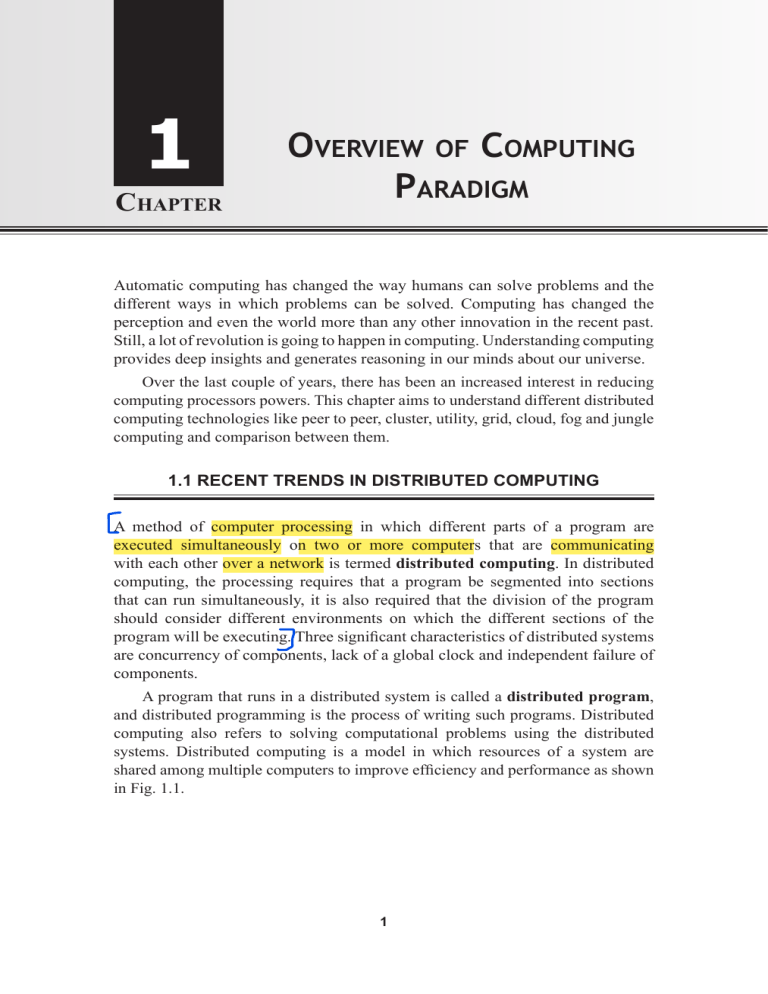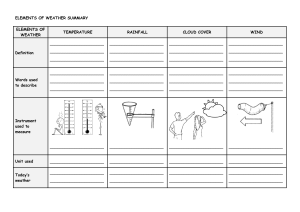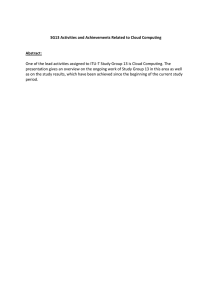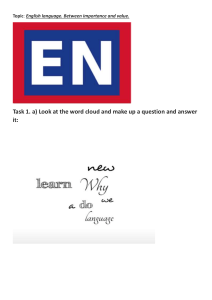
1 Chapter Overview of Computing Paradigm Automatic computing has changed the way humans can solve problems and the different ways in which problems can be solved. Computing has changed the perception and even the world more than any other innovation in the recent past. Still, a lot of revolution is going to happen in computing. Understanding computing provides deep insights and generates reasoning in our minds about our universe. Over the last couple of years, there has been an increased interest in reducing computing processors powers. This chapter aims to understand different distributed computing technologies like peer to peer, cluster, utility, grid, cloud, fog and jungle computing and comparison between them. 1.1 RECENT TRENDS IN DISTRIBUTED COMPUTING A method of computer processing in which different parts of a program are executed simultaneously on two or more computers that are communicating with each other over a network is termed distributed computing. In distributed computing, the processing requires that a program be segmented into sections that can run simultaneously, it is also required that the division of the program should consider different environments on which the different sections of the program will be executing. Three significant characteristics of distributed systems are concurrency of components, lack of a global clock and independent failure of components. A program that runs in a distributed system is called a distributed program, and distributed programming is the process of writing such programs. Distributed computing also refers to solving computational problems using the distributed systems. Distributed computing is a model in which resources of a system are shared among multiple computers to improve efficiency and performance as shown in Fig. 1.1. 1 2 Cloud Computing Fig. 1.1 Workflow of distributed systems Distributed computing system has following characteristics: • It consists of several independent computers connected via a communication network. • The message is being exchanged over the network for communication. • Each computer has its own memory, clock and runs its own operating system. • Remote resources are accessed through the network. Various classes of distributed computing shown in Fig.1.2 and it will be discussed further in the subsequent sections. Distributed computing P2P computing Cluster computing Grid computing Utility computing Jungle computing Cloud computing Fog computing Fig. 1.2 Taxonomy of distributed computing 1.1.1 Peer to Peer Computing When computers moved into mainstream use personal computers (PCs) were connected together through LANs (Local Area Networks) to central servers. These central servers were much more powerful than the PCs, so any large data processing can take place on these servers. After which PCs have become much more powerful, and capable enough to handle the data processing locally rather than on central servers. Due to this, peer-to-peer (P2P) computing can now occur Overview of Computing Paradigm 3 when individual computers by pass central servers to connect and collaborate directly with each other. A peer is a computer that behaves as a client in the client/server model. It also contains an additional layer of software that allows it to perform server functions. The peer computer can respond to requests from other peers by communicating a message over the network. P2P computing refers to a class of systems and applications that employ distributed resources to perform a critical function in a decentralized manner. The resources encompass computing power, data (storage and content), network bandwidth and presence (computers, human, and other resources) [3]. P2P computing is a network-based computing model for applications where computers share resources and services via direct exchange shown in Fig.1.3. Fig. 1.3 Peer to Peer network Technically, P2P provides the opportunity to make use of vast untapped resources that go unused without it. These resources include processing power for large-scale computations and enormous storage potential. The P2P mechanism can also be used to eliminate the risk of a single point of failure. When P2P is used within the enterprise, it may be able to replace some costly data centre functions with distributed services between clients. Storage, for data retrieval and backup, can be placed on clients. P2P applications build up functions such as storage, computations, messaging, security, and file distribution, through direct exchanges between peers. 1.1.2 Cluster Computing Cluster computing consists of a collection of interconnected standalone computers cooperatively working together as a single integrated computing resource to take advantage of the parallel processing power of those standalone computers. Computer clusters have each node set to carry out same tasks controlled and scheduled by software. The components of a cluster are connected to each other through fast local area networks as shown in Fig.1.4. Clustered computer systems 4 Cloud Computing have proven to be effective in handling a heavy workload with large datasets. Deploying a cluster increases performance and fault tolerance. Front-end Node Switch Node 1 Node 2 Node 3 Node 4 Fig. 1.4 Cluster computing Some major advantages of cluster computing are manageability, single system image and high availability. In the cluster, software is automatically installed and configured, and the nodes of the cluster can be added and managed easily. So, it is an open system that is very easy to deploy and cost-effective to acquire and manage. Cluster computing contains some disadvantages also. It is hard to manage cluster computing without experience. When the size of the cluster is large, it is difficult to find out if something fails. It’s programming environment is hard to be improved when software on some node is different from the other. The use of clusters as a computing platform is not just limited to scientific and engineering applications; there are many business applications that get benefit from the use of clusters. This technology improves the performance of applications by using parallel computing on different machines and also enables shared use of distributed resources. 1.1.3 Utility Computing Utility computing is a service provisioning model in which a service provider makes computing resources and infrastructure management available to the customer as per the need, and charges them for specific usage rather than a fixed rate. It has an advantage of low cost with no initial cost to afford the computer resources. This repackaging of computing services is the foundation of the shift to on-demand computing, software as a service and cloud computing models. Overview of Computing Paradigm 5 The customers need not to buy all the hardware, software and licenses to do business. Instead, the customer relies on another party to provide these services. Utility computing is one of the most popular IT service models primarily because of the flexibility and economy it provides. This model is based on that used by conventional utilities such as telephone services, electricity and gas. Customers have access to a virtually unlimited supply of computing solutions over the Internet or a virtual private network (VPN), which can be used whenever, where ever required. The back-end infrastructure and computing resources management and delivery are governed by the provider. Utility computing solutions can include virtual software, virtual servers, virtual storage, backup and many more IT solutions. Multiplexing, multitasking, and virtual multitenancy have brought us to the utility computing business as shown in Fig.1.5. Fig. 1.5 Utility computing 1.1.4 Grid Computing A scientist studying proteins logs into a computer uses an entire network of computers to analyze data. A businessman accesses his company’s network through a Personal Digital Assistant in order to forecast the future of a particular stock. An army official accesses and coordinates computer resources on three different military networks to formulate a battle strategy. All these scenarios have one thing in common : they rely on a concept called grid computing. At its most basic level, grid computing is a computer network in which each computer’s resources are shared with every other computer in the system. Processing power, memory and data storage are all community resources that authorized consumers 6 Cloud Computing can tap into and leverage for specific tasks. A grid computing system can be as simple as a collection of similar computers running on the same operating system or as complex as inter-networked systems comprised of every computer platform you can think of. The grid computing is basically a way to execute jobs across a distributed set of processors. Grid computing offers sharing of resources over geographically distributed locations. Collaborative nature of these grids leads to the concept of virtual organizations consisting of a dynamic set of data and resources to solve a specific task. The architecture of grid computing is shown in Fig.1.6. Grid computing divides a large program into sub-programs and assigns each sub-program to an individual processor. Each processor now processes the sub-program and returns the end result. Even if one processor fails, the result will not get affected because the task will be reassigned to another processor. A variety of resources may be shared, including computers, storage devices, network, data, software, sensors, or scientific instruments. Grid behaves like an independent entity and has its own control and administration. Grids can further be categorized into computational grids—these are grids that primarily focus on intensive and complex computations and data grids—grids for management and control of sharing of vast amounts of data. Fig. 1.6 Grid computing One of the advantages of grid computing is that enterprises don’t need to buy large servers for applications that can be split up and farmed out to smaller commodity type servers. Second, it’s more efficient in the use of resources. Grid environments are much more modular, and policies in the grid can be managed by the grid software. Overview of Computing Paradigm 7 1.1.5 Cloud Computing Cloud computing is a computing paradigm where computing is moved away from personal computers or an individual application server to a cloud of computers. Consumers of the cloud only need to be concerned with their computing needs, as all the underlying details are hidden to the consumer. Cloud computing provides a large pool of dynamically scalable and virtual resources as a service on demand. The services of a cloud are not limited to using web applications, but can also be IT management services such as requesting software stack, system or a specific web appliance. A cloud is a collection of resources that includes storage, servers, database, network, software, etc. Thus, cloud computing as shown in Fig. 1.7 is the delivery of applications, infrastructure and platform as a service over the Internet. These applications are on a pay-per-use basis and are accessible from the web browser and desktop with the customers not worrying about the service providing system as well as where the software and data are residing on the servers. There are a lot of reasons that make cloud computing very popular like it offers storage capacity beyond the limit and lower computer costs. Fig. 1.7 Cloud computing 8 Cloud Computing 1.1.6 Fog Computing Fog computing or fogging is a distributed computing infrastructure in which some application services are handled on a smart device, and some are handled in a remote data centre—on the cloud. The main objectives of fogging are to improve computing efficiency and reduce the amount of data that needs to be transferred to the cloud for storage, processing and analysis. Fig. 1.8 Fog Computing In a fog computing environment shown in Fig.1.8, the major processing takes place in a data hub on a smart mobile device or on a network in a router or other gateway device. This distributed approach is growing in popularity because of the Internet of Things (IoT) and the immense amount of data that are generated by sensors. It is inefficient to transfer all the data to the cloud for processing and analysis, as it requires a great deal of bandwidth and all the communication between the sensors and the cloud can reduce efficiency. 1.1.7 Jungle Computing Jungle computing is a combination of heterogeneous, hierarchical and distributed computing resources. Domain experts concurrently use multiple clusters, grids, clouds, desktop grids, independent computers and more in many realistic scientific research areas. Jungle computing refers to the use of diverse, distributed and highly non-uniform high-performance computer systems to achieve maximum performance. A collection of resources like standalone machines, cluster systems, grids, clouds, etc. as shown in the Fig.1.9, and this varied collection is termed jungle computing. Overview of Computing Paradigm 9 Fig. 1.9 Jungle Computing 1.1.8 Comparison of Various Computing Technologies Various classes of distributed computing have been discussed in the previous sub section, and each has its own special feature which makes it different from others. In this section the comparison of utility, cluster, grid and cloud computing is done in Table 1.1 which helps the reader to conclude these computing paradigms. Table 1.1: Comparison table of computing classes Feature Utility computing Cluster computing Grid computing Cloud computing Virtualization Some form of virtualization Half Half Essential Scalability Yes No Half: Nodes & Sites Yes Standardization and interoperability Standardization of backup policies Virtual interface architecture based Open grid forum standards Web services User management Centralized Centralized Decentralized Centralized or by third party Size 100s 100s 1000s 100s to 1000s Pricing Utility pricing Limited Dominated by public good or privately assigned Utility pricing discounted for larger customers Resource management Distributed Centralized Distributed Centralized or distributed Capability Based on service provisioning Stable and guarantee Varies but high On demand 10 Cloud Computing Control Centralized Centralized Decentralized Ownership Single Single Multiple Single Privacy Service level Medium level Medium level High level Transparency Yes Yes No, low Yes, high but optional Applications Business model Science, business and data centres Collaborative, scientific and HPC Web application and content delivery Examples Google, Amazon 2008 ARCnet, VAXcluster GIMPS, SET1 Amazon EC2 Centralized 1.2 VISION OF CLOUD COMPUTING The vision of cloud computing is that IT services are utilized as utilities in an open market place, without any technological and legal barriers. In this cloud market place, cloud service providers and consumers play a central role. Different stakeholders adopt cloud computing for a variety of services. The need for ubiquitous storage, computing power, on demand and pay per use are the most common reasons to adopt cloud computing. It is especially attractive to developers that do not have the infrastructure or cannot afford any further expansion of existing infrastructure. The capability for web-based access to documents and their processing using sophisticated applications is one of the appealing factors for users. Cloud infrastructure is very robust and is always available at any time. Computing services need to be highly reliable, scalable and capable of supporting ubiquitous access.We have seen a great progress of cloud computing in very short time. Now lets have a look at what may become of cloud computing technology in the future. • Cloud computing will become even more outstanding in the coming years with rapid, continued growth of major global cloud data centres. • Approximately 50% of all IT will be on the cloud within the next five to ten years. • There will be a greater use of cloud technology in emerging markets such as in the BRIC countries (Brazil, Russia, India and China) as they are developing and adopting new technologies rapidly. Particularly in Asia, there is already a trend to stay on the edge of the latest technology. • Data on the cloud will be available from everywhere in standardized formats. The security and reliability of cloud computing will continue to evolve, ensuring that data will be even more secure with numerous techniques employed.


